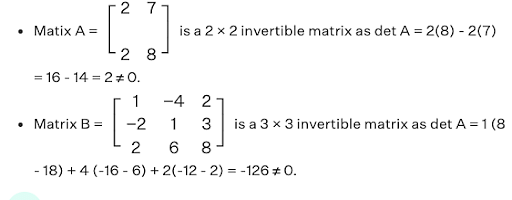Find the inverse of each of the matrices, if it exists. \(\begin{bmatrix} 1 & 3\\ 2 & 7\end{bmatrix}\)
Approach Solution - 1
Let \(A=\)\(\begin{bmatrix} 1 & 3\\ 2 & 7\end{bmatrix}\)
We know that \(A = IA\)
so\(\begin{bmatrix} 1 & 3\\ 2 & 7\end{bmatrix}\)= \(\begin{bmatrix} 1 & 0\\ 0 & 1 \end{bmatrix}A\)
⇒ \(\begin{bmatrix} 1 & 3\\ 0 & 1\end{bmatrix}\)= \(\begin{bmatrix} 1 & 0\\ -2 & 1\end{bmatrix}A\) \((R_2\rightarrow R_2-2R_1) \)
⇒ \(\begin{bmatrix} 1 & 0\\ 0 & 1 \end{bmatrix}=\begin{bmatrix} 7 & -3\\ -2 & 1 \end{bmatrix}A\) \((R_1\rightarrow R_1-3R_2) \)
\(\therefore A^{-1}\) =\(\begin{bmatrix} 7 & -3\\ -2 & 1 \end{bmatrix}\)
Approach Solution -2
\(\mathbf{A} = \begin{bmatrix} a & b \\ c & d \end{bmatrix}\)
The inverse \(\mathbf{A}^{-1}\) is:
\(\mathbf{A}^{-1} = \frac{1}{\det(\mathbf{A})} \begin{bmatrix} d & -b \\ -c & a \end{bmatrix}\)
where \(\det(\mathbf{A})\) (the determinant of \(\mathbf{A}\)) is given by:
\(\det(\mathbf{A}) = ad - bc\)
Given the matrix:
\(\mathbf{A} = \begin{bmatrix} 1 & 3 \\ 2 & 7 \end{bmatrix}\)
First, we compute the determinant \(\det(\mathbf{A})\):
\(\det(\mathbf{A}) = (1)(7) - (3)(2) = 7 - 6 = 1\)
Since the determinant is not zero, the inverse exists. Now, we apply the formula for the inverse:
\(\mathbf{A}^{-1} = \frac{1}{\det(\mathbf{A})} \begin{bmatrix} 7 & -3 \\ -2 & 1 \end{bmatrix}\)
Substituting \(\det(\mathbf{A}) = 1\):
\(\mathbf{A}^{-1} = \frac{1}{1} \begin{bmatrix} 7 & -3 \\ -2 & 1 \end{bmatrix} = \begin{bmatrix} 7 & -3 \\ -2 & 1 \end{bmatrix}\)
So, the answer is: \(\mathbf{A}^{-1} = \begin{bmatrix} 7 & -3 \\ -2 & 1 \end{bmatrix}\)
Top Questions on Matrices
- Let \( A = \begin{bmatrix} 1 & -2 & -1 \\ 0 & 4 & -1 \\ -3 & 2 & 1 \end{bmatrix}, B = \begin{bmatrix} -5 \\ -2 \end{bmatrix}, C = [9 \ \ 7], \) which of the following is defined?
- If \[ \begin{bmatrix} 4 + x & x - 1 \\ -2 & 3 \end{bmatrix} \] is a singular matrix, then the value of \( x \) is:
If \[ A = \begin{bmatrix} 1 & 2 & 0 \\ -2 & -1 & -2 \\ 0 & -1 & 1 \end{bmatrix} \] then find \( A^{-1} \). Hence, solve the system of linear equations: \[ x - 2y = 10, \] \[ 2x - y - z = 8, \] \[ -2y + z = 7. \]
- Find x, y, z if
\[ \begin{bmatrix} 5 & 1 & 0 \\ 1 & 1 & 1 \end{bmatrix} \begin{bmatrix} 0 & 1 & -2 \\ 1 & -2 & 3 \\ -1 & 1 & 1 \end{bmatrix} \begin{bmatrix} x-1 \\ y+1 \\ 2z \end{bmatrix} = \begin{bmatrix} 2 \\ 1 \end{bmatrix}. \] - Solve the following equations by the method of inversion: \( 2x-y+z=1 \), \( x+2y+3z=8 \), \( 3x+y-4z=1 \).
Questions Asked in CBSE CLASS XII exam
- The diagonals of a parallelogram are given by \( \mathbf{a} = 2 \hat{i} - \hat{j} + \hat{k} \) and \( \mathbf{b} = \hat{i} + 3 \hat{j} - \hat{k}\) . Find the area of the parallelogram.
- If \( \int \frac{1}{2x^2} \, dx = k \cdot 2x + C \), then \( k \) is equal to:
- CBSE CLASS XII - 2025
- Integration
- A rectangular glass slab ABCD (refractive index 1.5) is surrounded by a transparent liquid (refractive index 1.25) as shown in the figure. A ray of light is incident on face AB at an angle \(i\) such that it is refracted out grazing the face AD. Find the value of angle \(i\).

- CBSE CLASS XII - 2025
- Refraction
- If \( \mathbf{a} \) and \( \mathbf{b} \) are position vectors of two points \( P \) and \( Q \) respectively, then find the position vector of a point \( R \) in \( QP \) produced such that \[ QR = \frac{3}{2} QP. \]
- Three students run on a racing track such that their speeds add up to 6 km/h. However, double the speed of the third runner added to the speed of the first results in 7 km/h. If thrice the speed of the first runner is added to the original speeds of the other two, the result is 12 km/h. Using the matrix method, find the original speed of each runner.
Concepts Used:
Invertible matrices
A matrix for which matrix inversion operation exists, given that it satisfies the requisite conditions is known as an invertible matrix. Any given square matrix A of order n × n is called invertible if and only if there exists, another n × n square matrix B such that, AB = BA = In, where In is an identity matrix of order n × n.
For example,
It can be observed that the determinant of the following matrices is non-zero.
